Though I have yet to make it to the Minnesota State Fair this year, of course, it is the lead story on every local news broadcast and newspaper headline, so I am well aware of the proceedings thus far (low attendance due to the heat, and as always, crazy new foods to try). A recent report promoted the Department of Natural Resources (DNR) building, which this year is showcasing their recently renovated indoor aquariums that house a display of fish native to the state. Smaller, outdated tanks were replaced with five large tanks designed to show multiple species within particular habitats.
Being that I spent most of my summer amongst photographs and archival records related to game and fish from the late 1800s to the early 1900s, I wondered how Minnesota’s native animals were exhibited at the fair in years past. My search for answers reconnected me to a familiar name: H.J. Jager.
In the Annual Report of the Minnesota State Agricultural Society for 1921, the Department of Fish and Game reported their contributions to the 1921 Minnesota State Fair:
“The Fish and Game Department had for display its usual assortment of fish, which attracted a large number of people as is always the case.
In addition, a collection of wild animals and birds, including deer, foxes, raccoons, skunks, beavers, minks, bears, geese, ducks and pheasants, was installed in one of the old barns, vacated on account of the installing of the new cattle building. This was a somewhat new departure for Minnesota but proved very attractive and, in our opinion, should be extended and made an annual event. Not only is such an exhibit attractive to the visitor but it causes added interest to be taken in game farming which is fast becoming an important industry in our state.”
The report included a list of exhibitors, among which was listed a H.J. Jager of Owatonna. Jager exhibited black mallard ducks, Canada geese, cackling geese, blue geese, show geese, and white-fronted geese in the Department of Fish and Game exhibit at the State Fair that year. For some reason, that name seemed familiar to me…
Then I remembered the multiple caption notations that I recently made for a series of digital images of a set of glass plate negatives depicting geese, ducks, and other fowl from the Bell Museum of Natural History collection. H.J. Jager’s flock…. H.J. Jager’s flock… H.J. Jager’s flock…
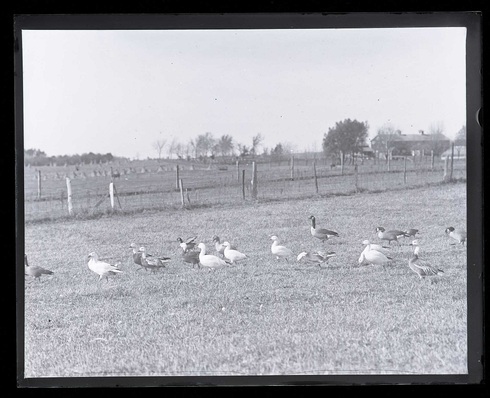
– Geese, mixed flock, H.J. Jager’s flock, October 15, 1916, Owatonna, MN
In October of 1916, T.S. Roberts, who by then was the Associate Curator of the Zoological Museum at the University of Minnesota, visited H.J. Jager in Owatonna in Steele County, Minnesota and produced a series of glass plate negatives that captured Jager’s flock of geese, ducks, and other feathered fowl.
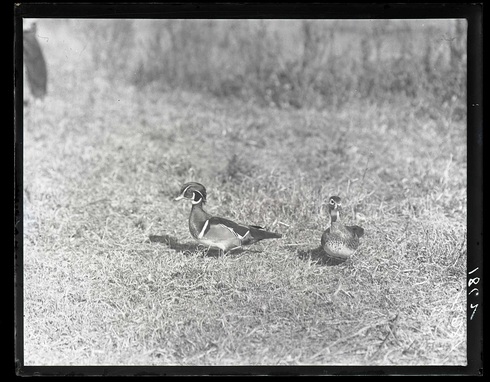
– Wood Duck, male and female, H.J. Jager’s flock, October 15, 1916, Owatonna, MN
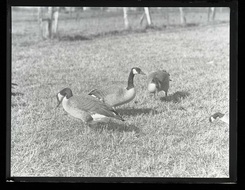
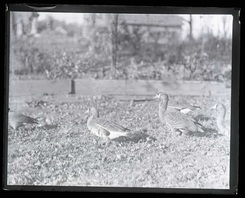
(l) Canada Geese, H.J. Jager’s flock, October 15, 1916, Owatonna, MN
(r) White-fronted Geese, H.J. Jager’s flock, October 15, 1916, Owatonna, MN
In another obscure link that populated from a general Google search, I navigated to the Biodiversity Heritage Library at Harvard University to find the journal, The Game breeder. The Game breeder was published by the Game Conservation Society, Inc. of New York City, and the tagline on the cover of the magazine indicated the purpose of the publication, “The object of this magazine is to make North America the biggest game producing country in the world.” Within the May 1919 edition of the publication is an article by E.D. Pickell (p.41-42) in which he stated, “I am enclosing photographs of a pair of Snow Geese which are owned on the game farm of H.J. Jager. This pair of Snow Geese are the first to my knowledge which have set and raised young in captivity.” He reported that Jager’s geese had already started to lay eggs in April of that year, and further described Jager and his flock:
“Mr. Jager, who, by the way, is a thorough naturalist, has one of the finest collections of wild game birds anyone could wish for. He and his wife are both taxidermists and they have one of the finest collections of mounted birds and animals, covering nearly all species of birds, both land and water fowl, and many species of small fur bearers. Mr. Jager only keeps his wild fowl for the pleasure he gets from caring for them. It is no unusual sight to see pheasants and other birds in their lovely plumage parading on his beautiful lawn. You will enjoy a visit with him among his birds and will be entertained like a prince.”
In the September, 1919 edition of The Game breeder, H.J. Jager himself provided full disclosure on “How to Breed Wild Geese and Wild Ducks” in a three-page article that included four illustrations of his flock.
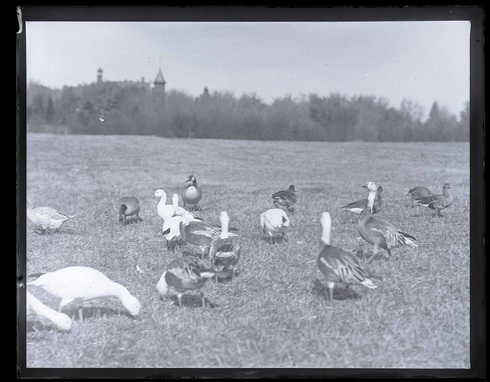
– Geese, mixed flock, H.J. Jager’s flock, October 16, 1916, Owatonna, MN
In addition to caring for his flock, Jager was a state agent at the Minnesota State Public School for Dependent and Neglected Children, the former home for orphaned, abused, and neglected children. In the photograph above you can see what appears to be the spire and tower of the school in the background. If you take the time to read Jager’s article (linked above) you will learn how he raised his geese and ducks in captivity – the care he took in preparing his yard with specially constructed pens to create different habitats, the special food he made for his fowl (lettuce, bread soaked in sweet milk), and the attention he gave to keeping their water dishes clean and their grain bowls full. One can’t help but to think that the compassion and attention that Jager showed in pursuit of his avocation was in some way inspired by the compassion and attention required for his occupation.